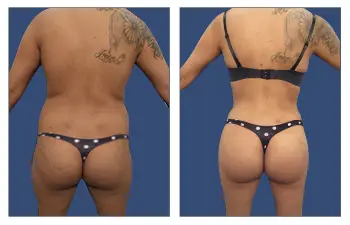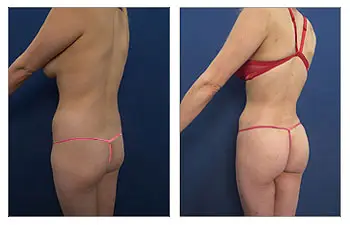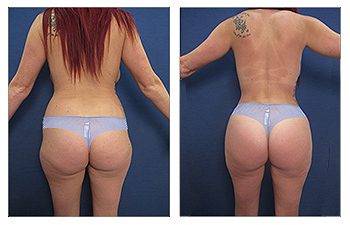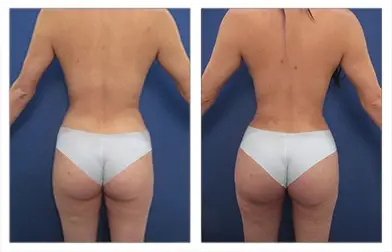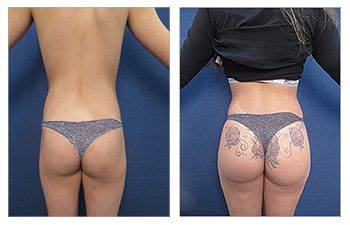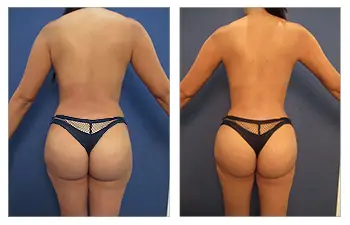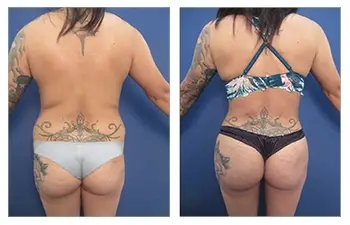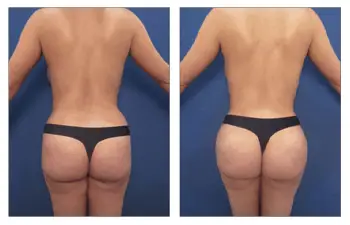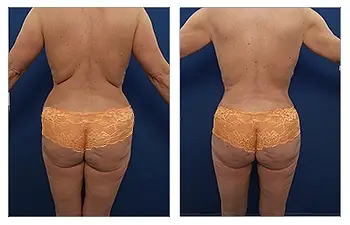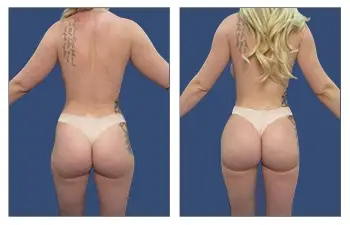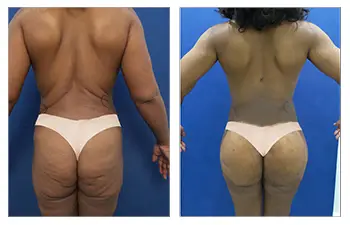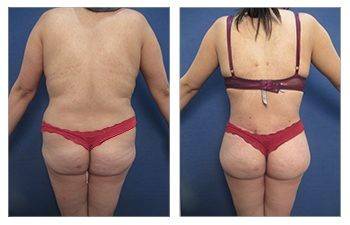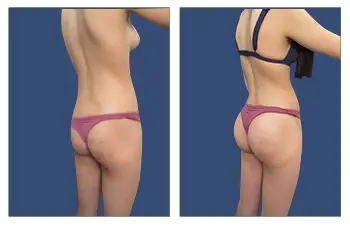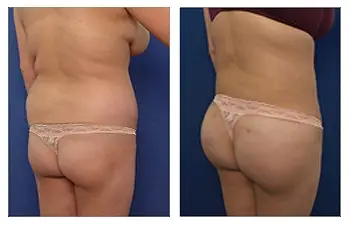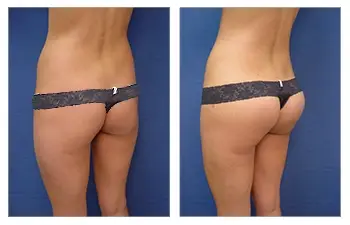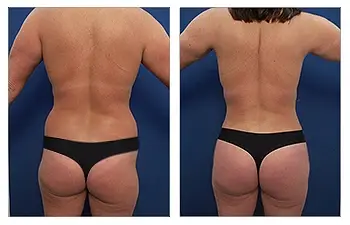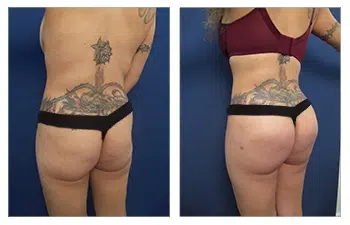Hip Dips are a natural part of the human body structure, often misunderstood and underrepresented in mainstream beauty standards. The presence or absence of these indentations on your hips doesn’t determine your health or fitness level. They’re more about genetics and bone structure than anything else. The variations we see are what make us beautifully diverse.
Hip Dips don’t require treatment unless they cause discomfort or impact functionality. Let’s dive deeper into understanding them beyond societal perceptions.
Understanding Hip Dips Introduction
In the realm of body image and beauty standards, the term “hip dips” has emerged as a topic of discussion and even concern for many individuals. Hip dips refer to the slight inward curve or depression that can appear on the sides of the hips, just below the hip bone. We will explore the anatomy of hip dips, debunk common myths, and discuss the gold standard in hip dips correction.
The Anatomy of Hip Dips
To understand hip dips, it’s essential first to grasp the anatomical factors that contribute to their appearance. Hip dips are not a flaw or deformity but rather a natural variation in body shape influenced by several key factors.
Hip dip’s normal contour may appear as a flattening of the female silhouette that is most affected by the bone structure of the hip bones but also affected by the prominence of the love handles that are affected by the volume of fat underlying, wrapped gluteus medius muscle as well as the lateral thighs.
The hip dip normal contour is affected by your body shape and stance, such as standing or sitting. In summary, hip flexors, gluteus maximus muscles, body fat stores, and bone shape affect the hip’s dips.
A. Pelvic Structure
The primary contributor to hip dips is the individual’s pelvic structure. Human pelvises come in various shapes and sizes, and these differences significantly impact the appearance of the hips. A high and prominent iliac crest (the upper edge of the hip bone) can create a more noticeable dip between the hip bone and the thigh, contributing to the appearance of hip dips.
B. Distribution of Fat and Muscle
Fat and muscle distribution around the hips plays a role in the visibility of hip dips. Some individuals may naturally store more fat above and below their hips. Generous fat, either above in the flank region or below in the lateral thigh region, can accentuate the dips.
In contrast, others may have a more even fat distribution, resulting in a smoother hip contour. Additionally, muscle development in the hip and thigh areas can influence the appearance of hip dips. Stronger and more developed muscles may fill in the dips, creating a smoother transition from the hip bone to the thigh.
C. Superficial Fat
Superficial fat, which is the fat located just beneath the skin, varies among individuals. The thickness and distribution of subcutaneous fat can affect the prominence of hip dips. Thicker superficial fat may conceal the dips, while a thinner superficial fat layer can make them more noticeable.
Common Myths About the Hip Dips
The existence of hip dips has given rise to various myths and misconceptions, often perpetuated by societal beauty standards and social media. It’s crucial to debunk these myths to foster a healthier and more accepting perspective on body diversity.
A. Myth- Hip Dips Are Unattractive
One prevalent myth is that hip dips are unattractive, and individuals with hip dips should seek ways to conceal or correct them. Beauty is highly subjective, and what one person finds attractive, another may not. Subtle hip dips can appeal to athletes as somewhat flattened hips convey a toned buttock cheek.
Attractiveness is not solely determined by body shape; many people find these subtle hip dips beautiful and a sign of being in shape.
B. Myth: Hip Dips Can Be Eliminated Through Exercise
While exercise can tone and shape the muscles around the hips and thighs, it cannot fundamentally change the underlying structure of the pelvis or alter the distribution of subcutaneous fat. Consequently, it is a misconception that targeted exercises can eliminate hip dips.
Moreover, exercise can enhance overall muscle tone and contribute to a more sculpted appearance; however, it won’t necessarily eliminate hip dips. If you are plus size, weight loss can improve the appearance of your hip dips by reducing the degree of prominence in your flanks and lateral thighs.
C. Myth: Hip dips can occur in people with various body types and are not solely indicative of being plus size.
Hip dips are not solely dependent on an individual’s weight or body mass index (BMI). People of all body types and sizes can have hip dips as it is affected by your pelvic bone configuration.
Weight loss or gain may exaggerate the overall appearance of the hips, but it may not necessarily eliminate hip dips. Weight gain may increase the prominence of your flanks and lateral thighs, resulting in deeper hip dips.
Correction of Hip Dips
Correction of hip dips involves three maneuvers to fill in the hip dips. These include a combination of a)reducing the prominence of the flanks and lateral thighs, b) filling in the dips themselves, and c)tenting up the skin that spans across the hip dips.
- Reducing the prominence of the flanks and lateral thighs requires liposuction to eliminate excess fat. While traditional liposuction is effective for lateral thigh removal, removing flank fat can be more challenging. This is primarily because flank fat is highly compartmentalized and exists in three separate layers, unlike other body areas where fat is found in only the superficial and deep layers. In most cases, the superficial fat is typically left untouched unless specific procedures like abdominal etching are performed to highlight muscle definition. Consequently, liposuction typically focuses on removing the deep fat layer. Interestingly, the flank region often possesses deep fat and a central fat layer, which is difficult to remove with traditional liposuction. It Is helpful to use ultrasound energy to loosen the fat before suctioning to remove both the central and deep fat.
- Filling the hip dips requires the use of fat transfer technology. This technology describes the ability to harvest fat from other places, as discussed above, effectively and then transfer it back into the hip dips. One constraint to fat transfer in the hips is structural support fibrous cables that keep the hip skin attached to the pelvis. These attachments can often be loosened with a PALS machine, which utilizes the percussive movements of a cannula to break up any tight bands during fat transfer.
- The lateral thigh and buttock tuck remain the gold standard in eliminating hip dips by tightening excess skin spanning the dips. By tightening the skin spanning over the dips, you get a tenting, eliminating the dips.
Hip dips are a natural human body aspect influenced by pelvic structure, fat distribution, skin redundancy, and individual genetics. Debunking common myths and promoting body positivity is essential to ensure that individuals of all body types and shapes feel accepted and valued.
Regardless, eliminating prominent dips is a definite desire of women universally who desire to create an hourglass shape that is depicted by full hips and a narrower waistline. Hip dip correction using surgical maneuvers is a recognized and established procedure in the cosmetic world.
Understanding Hip Dips
Hip dips, or violin hips, are a common physical characteristic. They are the slight inward curves below each hip bone many people have on their sides. These naturally occurring indentations do not indicate any health issues or fitness levels but rather an aspect of human anatomy that varies in appearance.
The Science Behind Hip Dips
A deeper dive into anatomical research reveals that these dips occur due to the spacing between your pelvis and femur. The width and shape of these bones can influence how noticeable your hip dips are.
Muscle mass plays its part, too – for instance, if you have more developed gluteal muscles (buttocks), they might stick outwards, making any dip seem less pronounced.
The Role of Genetics in Hip Dips
Genetics plays a significant role in determining whether you will have prominent hip dips. Genetics governs factors like skeletal structure and body fat distribution patterns (source).
Your genetic makeup determines where fat gets stored in your body, which could make these depressions appear more visible, especially when substantial fatty tissue surrounds this region.
Debunking Beauty Standards: Embracing Hip Dips
In our society, heavily influenced by social media beauty standards, it is easy to feel pressured to achieve certain looks, including rounded hips without indentations. However, such ideals overlook one crucial fact: everyone’s anatomy is unique.
As such, features like “hip dips” should be embraced as natural variations instead. While specific exercise routines to increase muscle mass around hips might minimize their appearance, no diet can eliminate them because they are structurally determined.
With an understanding of what constitutes hip dips established, let us delve further into various factors contributing towards their formation next.
Understanding Hip Dips: A Comprehensive Guide to Embrace Your Body Shape
Hip dips are a natural part of human anatomy, but what causes them? Understanding these factors can help you better appreciate your unique body shape.
Bone Structure: The Architect Behind Hip Dips
The structure of our bones is the primary factor behind hip dips. Your skeletal architecture plays a significant role in this phenomenon, including the width of your hips, the size and positioning of the greater trochanter, and distances between bones. Studies have demonstrated that variations in these aspects lead to different levels of visibility for hip dips.
Fat Distribution: Hormonal Influences on Hip Dip Appearance
Your hormones don’t just control mood swings or metabolism – they also dictate how fat gets distributed around your body. This includes areas such as your hips where uneven distribution or accumulation due to hormonal imbalances could accentuate hip dip appearance.
Muscle Mass Reduction with Aging: Its Impact on Hip Dip Formation
Aging inevitably brings about changes in our bodies; one such change is muscle mass reduction, which affects various parts, including our hips. Over time, the loss may enhance any natural indents and affect body fat distribution, thus making hip dips more noticeable.
All these factors contribute to creating individualistic body shapes inclusive or exclusive of visible ‘hip dip’ characteristics. Grasping their impact helps us accept and celebrate their presence instead of regard them as irregularities or flaws.
Understanding Hip Dips: A Comprehensive Guide to Embrace Your Body Shape
The phenomenon of hip dips is a natural occurrence that many individuals experience. In aesthetics and body contouring, various options are available to modify our physical appearances. However, it is important to question whether altering these features is necessary or if we should shift our focus toward embracing our bodies as they are.
Fat Grafting: A Potential Solution for Hip Dip Alteration?
Regarding cosmetic plastic surgery, fat grafting is one potential solution for individuals seeking changes in their hip dip appearance. This procedure involves transferring fat from other body parts into the hips, helping to create a smoother contour.
“While strengthening hip muscles and building muscle mass in the hips can enhance overall shape and tone, they cannot completely eliminate hip dips.” Dr. Babak Moein
This statement emphasizes that exercises targeting the hip muscles can improve aesthetic appeal to some extent. Still, they cannot eliminate hip dips due to genetic factors that influence bone structure.
Navigating Social Media Influences on Body Image
In today’s digital age, social media often shapes beauty standards and influences our perceptions of the “ideal” body. This includes smooth curves, which can overshadow natural features such as hip dips. Navigating our self-image in the face of these influences can be challenging.
“The key is embracing individual differences rather than succumbing to societal pressures presented online.”
It is important to embrace and accept our unique body shapes, understanding that functionality and overall well-being are more important than conforming to societal pressures presented online.
Moving Towards Function Over Form
Let’s not just chase looks but go for a bigger win – boosting our strength and stability. Doing this increases our well-being and shows us how key parts, like the hips, move us around. Want more on why function beats beauty tweaks? Check out this.
Function over Form: A Shift in Perspective
A noticeable alteration has been seen in physical fitness, with a move towards emphasizing robustness and steadiness. It is not just about our bodies’ appearance but also their performance.
This change is particularly relevant when discussing hip health. Why? Because research, such as this NCBI study, underscores the importance of focusing on functionality over appearance.
Hip-Strengthening Exercises: The Functional Advantage
What does it mean to focus on function rather than form? When we talk about hips, for instance, strengthening exercises do more than sculpt your silhouette; they enhance mobility and reduce the risk of injury.
A robust set of hips is a stable base for upper body movements while aiding balance during walking or running activities. This means prioritizing hip strength is important for maintaining an active lifestyle without undue strain or discomfort.
The Power of Stability Over Aesthetics
We live in a society where aesthetic standards often pressure individuals into altering their natural physique. However, pursuing stability over aesthetics makes more sense when considering ‘hip dips,’ an anatomical feature determined by the individual skeletal structure and muscle mass distribution.
Rather than attempting cosmetic alterations that may only result in superficial changes at best, wouldn’t it be wiser to concentrate on strengthening these muscles, thereby improving functional performance?
Moving Forward with Hip-Focused Exercises
Let’s explore specific workouts designed primarily for targeting muscles surrounding the hip region next.
Exercises Targeting Hips
The contours of your hips can be subtly influenced through targeted exercises. Although they may not entirely eradicate hip dips, these workouts tone and fortify the muscles surrounding the hips, enhancing stability.
Leg Lifts for Hips
A technique that deserves your attention is leg lifts. Primarily focusing on the muscles in your hips and thighs, this exercise begins with you lying on one side with your legs stacked together. The top leg is slowly lifted as comfortably as possible before being lowered back down.
Glute Bridges Technique
In a similar vein, glute bridges offer an excellent workout regimen. This exercise primarily targets your buttocks but engages the muscles around your hips when performed correctly. To execute a glute bridge correctly, lie on your back with bent knees and feet planted firmly on the ground, then press through heels to raise the pelvis until the body forms a straight line from shoulders to knees before lowering it gently.
Curtsy Lunges Benefits
If diversity in routine appeals to you, consider adding curtsy lunges into the mix due to their dual action that focuses on both quadriceps and glutes, thereby indirectly toning up those challenging hip areas, too. During the execution of the lunge, it’s crucial always to keep the front knee aligned over the ankle while maintaining good posture throughout the movement sequence.
Leg Raises Execution & Leg Kickbacks Challenge
To further refine those hip lines, leg raises are popular among fitness enthusiasts who seek a more defined physique despite natural dip formations commonly seen among the general population. In executing this move, lie face-down, extending arms out in front while lifting one or both legs upward, keeping them straight at all times.
Lastly, kickbacks: standing tall, bend forward slightly at the waist, point toes towards the floor behind you before kicking the raised foot backward, then return to the original position, repeating several times each set. Both these moves provide fantastic opportunities for engaging key muscle groups involved in shaping the overall appearance of our hips, giving them a firmer look and feel over time.
Dealing with Pain Associated with Hips
Did you know that discomfort in your hips and knees may be interconnected? It’s a little-known fact that weak muscles around the hip area can lead to pain. But don’t worry; this can often be improved through targeted exercises.
Common Issues Related to Hips
Our hip joint is a key component of our physical activity, as it is one of the largest joints in our body. Any imbalance or weakness here may ripple into other areas, causing issues like lower back pain, knee discomfort, or even alterations in gait.
This underscores why strengthening your hip muscles is crucial for overall mobility and comfort. It not only helps alleviate existing problems but also significantly aids in preventing further injuries.
Addressing Knee Pain
Knee pain may seem unrelated to your hips at first glance; however, these two areas are deeply intertwined within our body mechanics – an issue in one often impacts the other.
If you’re experiencing persistent knee discomfort despite no direct injury to the knee, weak hip muscles could be contributing factors. A physical therapist can guide you toward personalized exercises to strengthen these specific muscle groups, which will help relieve pressure from your knees.
Hip Pain Prevention
Taking a proactive approach towards managing potential sources of pain involves regular exercise focused on strength training around our core and hip areas. These workouts enhance stability while promoting healthier joints by keeping them flexible and resilient against wear-and-tear damage.
As we delve into understanding body diversity (our next topic), remember that maintaining strong, healthy hips isn’t just about appearances—it’s integral for functional movement without discomfort.
Celebrating Body Diversity: A Step Towards Self-Acceptance
Body diversity is more than just a buzzword. It’s a revolution in how we perceive beauty, pushing us to question and challenge traditional standards of physical attractiveness. This trend towards self-acceptance can be seen through the rise of #hipdip on Instagram, an online movement celebrating hip dips – natural indentations along some people’s hips.
“Hip dips are not flaws but unique body features that make us who we are.”
In essence, it’s about embracing our distinctive characteristics rather than striving for unattainable ideals often portrayed by mainstream media.
Hip Dips: Natural Beauty Personified
The concept behind #hipdip is simple yet powerful. By sharing photos of their hip dips, individuals worldwide inspire others to love themselves as they are and foster an environment where all body types are celebrated equally.
- Understanding Hip Dips: These indents occur due to variations in skeletal structure and fat distribution; hence, they’re entirely normal.
- #HipDip Movement: Instead of opting for cosmetic procedures like SurgiSculpt, many embrace this feature as part of their unique physique, thus encouraging positive body image over mere appearances.
Awareness Fuels Acceptance
Much like any other social change, acceptance begins with awareness. The broader our understanding of diverse body shapes, including features such as hip dips, the greater our ability to appreciate them without societal bias or pressure.
Prioritizing Health Over Appearances
| Beyond Aesthetics: |
|---|
| Keeping your health in check through balanced meals and consistent workouts is key. Self-confidence is achieved by gaining a sense of assurance, no matter the individual. |
FAQs about Hip Dips
Understanding Hip Dips: A Comprehensive Guide to Embrace Your Body Shape
What are hip dips caused by?
Your skeletal structure causes hip dips, specifically the spacing between your hip and femur bones. Other factors, such as muscle mass and fat distribution, can also influence their appearance.
Are hip dips good or bad?
Hip dips are neither good nor bad. They are a natural part of the human body shape variation. It is important to focus on health rather than physical appearance.
Can you get rid of hip dips?
No, exercises or lifestyle changes cannot eliminate hip dips as they are largely determined by genetics and bone structure.
What body type has hip dips?
All body types can have hip dips. The visibility of hip dips varies depending on individual differences in bone structure, muscle mass, and fat distribution around the hips.
Conclusion
- Embracing this unique feature can be empowering in the face of unrealistic beauty standards.
- While exercises may tone the muscles around your hips, they won’t eliminate hip dips – that’s okay!
- Your focus should ideally shift from aesthetics to functionality, with strength and stability taking precedence over physical appearances.
- Pain associated with weak hip muscles can often be managed through targeted exercises or physical therapy.
- Celebrate body diversity and challenge conventional beauty norms. Embrace your hip dips as a sign of individuality rather than an imperfection to fix.
SurgiSculpt, our cosmetic plastic surgery project, invites you to learn more about embracing all aspects of your physique, including Hip Dips. Explore ways to improve overall health while maintaining self-acceptance. We’re here for every step on your journey towards greater self-confidence, just as you are!

